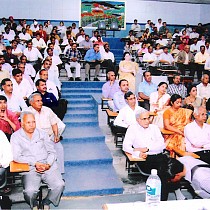POPULATION DYNAMICS AND DAMAGE POTENTIAL OF WHITE GRUB (COLEOPTERA: SCARABAEIDAE) COMPLEX IN POTATO CROP OF NORTH WESTERN INDIAN HILLS
Central Potato Research Institute, Shimla–1, India; Department of Biosciences, Himachal Pradesh University,
Shimla–5, India; Correspondence add– Entomology lab, Central Potato Research Institute, Shimla–1, India
ANUPAM SHARMA, D. R.THAKUR2 AND V.K. CHANDLA
Faunal composition of scarabaeids associated with potato crop in Shimla and Sirmmour districts of Himachal Pradesh(India) was investigated and a survey on grub population and tuber damage was carried out at five locations including Shimla, Fagu, Shillaroo, Kharapathar and Kheradhar during 2007–08. Weekly catches of adult beetles from light traps were also recorded from all locations except Shillaroo. During the survey in three consecutive years (April 2007 to August 2009) seven species of scarabaeid beetles belonging to four genera representing two sub families Melolonthinae and Rutelinae were recorded. Among the identified species, Brahmina coriacea (71.39%) was predominant followed by Holotrichia longipennis (12.33%) and B. flavoserica (8.24%) at all the surveyed locations, during study period. Other species encountered were Anomala dimidiata (2.82%), B. cirinicollis (2.38%), A. lineatopennis (1.82%) and Lepidiota stigma (1.49%). The scarabaeid adult emergence began soon after the first rain either during last week of May or early June and continued up to the end of July or beginning of August in North Western Indian hills. Mean number of grubs per plant and percent tuber damage was found maximum at Kharapathar (15.5 and 44) and minimum at Shimla (4.45 and 8.1). A positive correlation between beetle population and rainfall during three years was also observed.


